Intel Pentium 4 6xx and 3.73EE: Favoring Features Over Performance
by Anand Lal Shimpi & Derek Wilson on February 21, 2005 6:15 AM EST- Posted in
- CPUs
Workstation Applications
Visual Studio 6
Carried over from our previous CPU reviews, we continue to use Visual Studio 6 for a quick compile test. We are still using the Quake 3 source code as our test and measure compile time in seconds. The results are pretty much in line with what we've seen in the past.
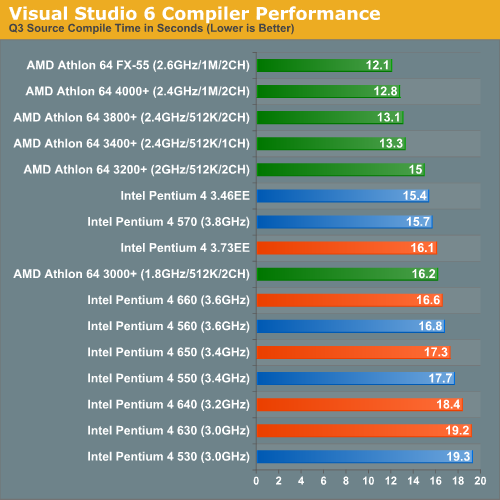
SPECviewperf 8
For our next set of professional application benchmarks we turn to SPECviewperf 8. SPECviewperf is a collection of application traces taken from some of the most popular professional applications, and compiled together in a single set of benchmarks used to estimate performance in the various applications the benchmark is used to model. With version 8, SPEC has significantly improved the quality of the benchmark, making it even more of a real world indicator of performance.
We have included SPEC's official description of each one of the 8 tests in the suite.
3dsmax Viewset (3dsmax-03)
"The 3dsmax-03 viewset was created from traces of the graphics workload generated by 3ds max 3.1. To insure a common comparison point, the OpenGL plug-in driver from Discreet was used during tracing.
The models for this viewset came from the SPECapc 3ds max 3.1 benchmark. Each model was measured with two different lighting models to reflect a range of potential 3ds max users. The high-complexity model uses five to seven positional lights as defined by the SPECapc benchmark and reflects how a high-end user would work with 3ds max. The medium-complexity lighting models uses two positional lights, a more common lighting environment.
The viewset is based on a trace of the running application and includes all the state changes found during normal 3ds max operation. Immediate-mode OpenGL calls are used to transfer data to the graphics subsystem."
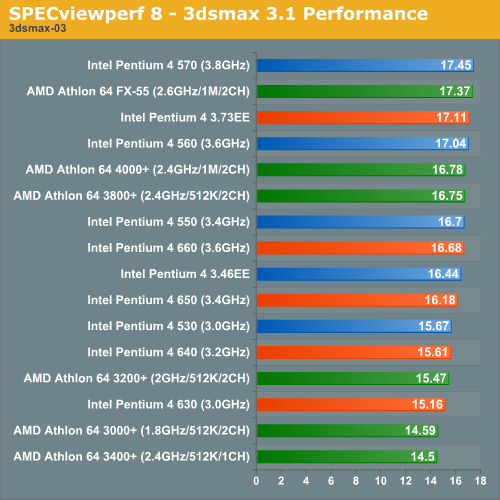
CATIA Viewset (catia-01)
"The catia-01 viewset was created from traces of the graphics workload generated by the CATIATM V5R12 application from Dassault Systems.
Three models are measured using various modes in CATIA. Phil Harris of LionHeart Solutions, developer of CATBench2003, supplied SPEC/GPC with the models used to measure the CATIA application. The models are courtesy of CATBench2003 and CATIA Community.The car model contains more than two million points. SPECviewperf replicates the geometry represented by the smaller engine block and submarine models to increase complexity and decrease frame rates. After replication, these models contain 1.2 million vertices (engine block) and 1.8 million vertices (submarine).
State changes as made by the application are included throughout the rendering of the model, including matrix, material, light and line-stipple changes. All state changes are derived from a trace of the running application. The state changes put considerably more stress on graphics subsystems than the simple geometry dumps found in older SPECviewperf viewsets.
Mirroring the application, draw arrays are used for some tests and immediate mode used for others."
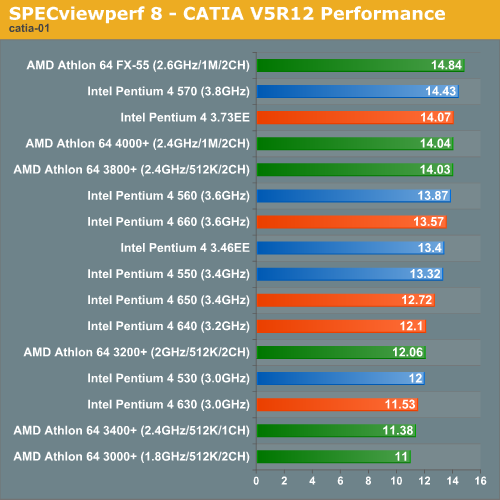
Lightscape Viewset (light-07)
"The light-07 viewset was created from traces of the graphics workload generated by the Lightscape Visualization System from Discreet Logic. Lightscape combines proprietary radiosity algorithms with a physically based lighting interface.
The most significant feature of Lightscape is its ability to accurately simulate global illumination effects by precalculating the diffuse energy distribution in an environment and storing the lighting distribution as part of the 3D model. The resulting lighting "mesh" can then be rapidly displayed."
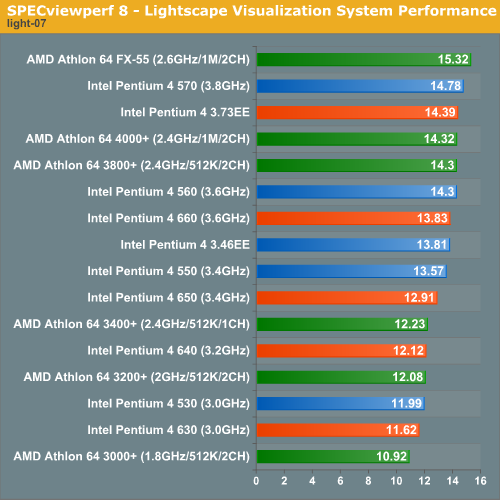
Maya Viewset (maya-01)
"The maya-01 viewset was created from traces of the graphics workload generated by the Maya V5 application from Alias.
The models used in the tests were contributed by artists at NVIDIA. Various modes in the Maya application are measured.
State changes as made by the application are included throughout the rendering of the model, including matrix, material, light and line-stipple changes. All state changes are derived from a trace of the running application. The state changes put considerably more stress on graphics subsystems than the simple geometry dumps found in older viewsets.
As in the Maya V5 application, array element is used to transfer data through the OpenGL API."

Pro/ENGINEER (proe-03)
"The proe-03 viewset was created from traces of the graphics workload generated by the Pro/ENGINEER 2001TM application from PTC.
Two models and three rendering modes are measured during the test. PTC contributed the models to SPEC for use in measurement of the Pro/ENGINEER application. The first of the models, the PTC World Car, represents a large-model workload composed of 3.9 to 5.9 million vertices. This model is measured in shaded, hidden-line removal, and wireframe modes. The wireframe workloads are measured both in normal and antialiased mode. The second model is a copier. It is a medium-sized model made up of 485,000 to 1.6 million vertices. Shaded and hidden-line-removal modes were measured for this model.
This viewset includes state changes as made by the application throughout the rendering of the model, including matrix, material, light and line-stipple changes. The PTC World Car shaded frames include more than 100MB of state and vertex information per frame. All state changes are derived from a trace of the running application. The state changes put considerably more stress on graphics subsystems than the simple geometry dumps found in older viewsets.
Mirroring the application, draw arrays are used for the shaded tests and immediate mode is used for the wireframe. The gradient background used by the Pro/E application is also included to better model the application workload."
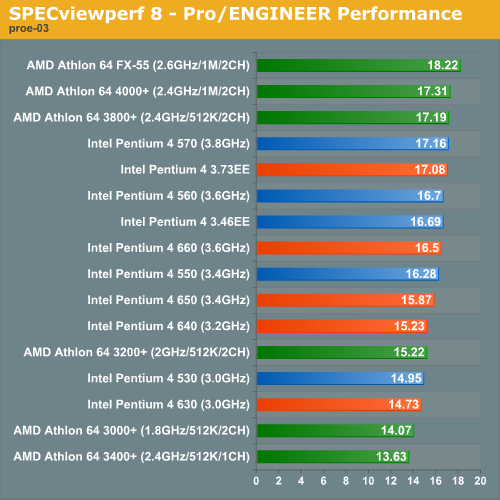
SolidWorks Viewset (sw-01)
"The sw-01 viewset was created from traces of the graphics workload generated by the Solidworks 2004 application from Dassault Systemes.
The model and workloads used were contributed by Solidworks as part of the SPECapc for SolidWorks 2004 benchmark.
State changes as made by the application are included throughout the rendering of the model, including matrix, material, light and line-stipple changes. All state changes are derived from a trace of the running application. The state changes put considerably more stress on graphics subsystems than the simple geometry dumps found in older viewsets.
Mirroring the application, draw arrays are used for some tests and immediate mode used for others."
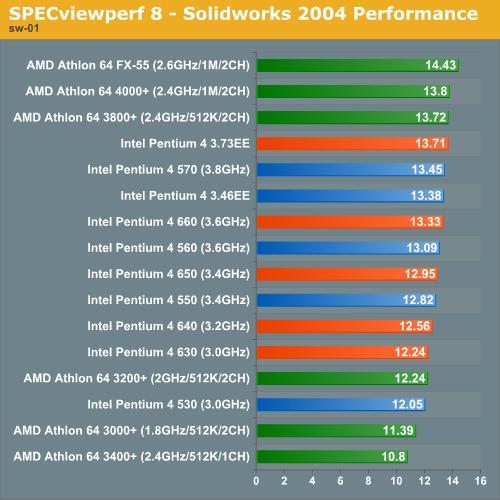
Unigraphics (ugs-04)
"The ugs-04 viewset was created from traces of the graphics workload generated by Unigraphics V17.
The engine model used was taken from the SPECapc for Unigraphics V17 application benchmark. Three rendering modes are measured -- shaded, shaded with transparency, and wireframe. The wireframe workloads are measured both in normal and anti-alised mode. All tests are repeated twice, rotating once in the center of the screen and then moving about the frame to measure clipping performance.
The viewset is based on a trace of the running application and includes all the state changes found during normal Unigraphics operation. As with the application, OpenGL display lists are used to transfer data to the graphics subsystem. Thousands of display lists of varying sizes go into generating each frame of the model.
To increase model size and complexity, SPECviewperf 8.0 replicates the model two times more than the previous ugs-03 test."
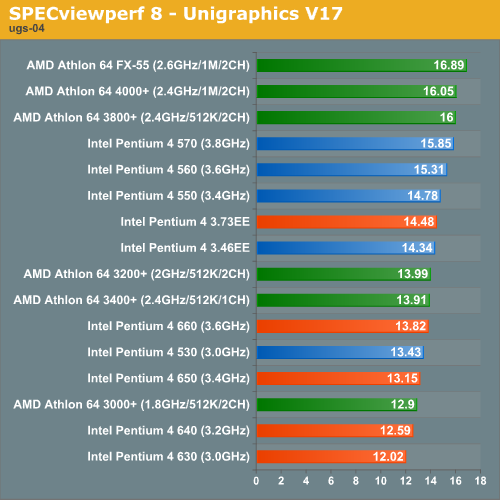










71 Comments
View All Comments
johnsonx - Monday, February 21, 2005 - link
Is there no merit at all in running a few A64 vs P4 6xx benchmarks with the current RC build of XP x64? While I've found too many things I need don't work with XP x64 to use it, I did see that 3dMark03 ran fine. I know 3dMark itself isn't 64-bit, bit it does making heavy use of 64-bit DirectX and graphic driver calls. There must be a few more apps and games that could be called on...Maybe just limit the benchies to two processors, say an A64 3500+ vs. a Pentium 4 650, running the same benchmarks in 32-bit and 64-bit Windows, using just one GeForce 6xxx and one Radeon X8-something.
It'd just be interesting and useful to see which processor runs 64-bit code better, both absolutely and compared to each processor's 32-bit performance.
When the final release version of XP x64 does come out, it may be interesting to have benchmarks from the RC version to see what's improved (though I agree it wouldn't actually be useful in any practical sense).
Or perhaps Anandtech knows something I don't, like the release XP x64 is so close that running benches on the RC would be moot....
SLIM - Monday, February 21, 2005 - link
#30 and 36Hans is right, the 3000 and 3200 cores in the graphs are not available in retail (downclocked 130nm cores) and are meant to show power consumption scaling with speed increases. It's unfortunate that they left out the more interesting comparison (the 130nm 3500+). The only 90nm AMD chip in the power graphs is the 3500+.
coldpower27 - Monday, February 21, 2005 - link
Very strange your the only guys so far that show an increase in power consumption of the P4 6xx Series over the 5xx Series.Regs - Monday, February 21, 2005 - link
Wow, a lot of good comments here. mlittl3, most of the Anandtech's population know that the EE's are just overpriced Northwood's on steroids (Big heads, small balls). And the crayon wax melting comparison made me laugh out loud.I just find it funny Intel is trying to slap on everything but the kitchen sink on these processors to make them more appealing. What's next? Are they going to come with a microwave toaster oven combo? With all do respect to Intel, to add on such features is not an easy thing to do at a engineering level but once again I feel that their marketing team is still running the show.
But what is AMD doing while Intel performs CPR on their Prescott's? All this news on Intel for the past few months left me nostalgic in what AMD is doing behind the scenes. SSE3 was their latest slap-on feature, but as we saw in your recent AMD article it offered little to no performance gain. AMD's next core has to offer lower L1-l2 Cache latencies. This is the only way I see AMD cornering Intel's Cores performance in every application. But im afraid we won't see any such thing until long-horn comes out in a few years. Until now we have to settle for worthless add-ons features for the desk-top consumers while we see both Intel and AMD battle the server market where Intel is mostly threatened.
HardwareD00d - Monday, February 21, 2005 - link
In Soviet Russia, Prescott melts YOU!miketheidiot - Monday, February 21, 2005 - link
why do the 3000 and 3200 have signifigantly higher power consumption than the 3500? I thought all 3200 and 3000 are also built on 90nm soi.RadeonGuy - Monday, February 21, 2005 - link
Even With All the processors haveing 2mb cache they still suck assHans Maulwurf - Monday, February 21, 2005 - link
#30 I think the 3000 and 3200 are not really Winchester cores. Maybe clocked down 130 nm cores.I´m interested in the memory timing of the A64. Is it 1T or 2T? This is an important information, you should always(!) give it the configuration part of reviews.
DerekWilson - Monday, February 21, 2005 - link
One thing to remember about out power tests --We measure power draw at the wall. Power supplies are inefficient and magnify power draw at the wall. Power input to the PSU does not scale proportionally to power output.
Brian23 - Monday, February 21, 2005 - link
I thought that all winchesters were 90nm SOI.